|
The HD-DVD/Blu-ray debate, Mobile video, 1080p HDTV, many television display refinements, Internet Services & Content delivery are some of the major themes in this year's CES. Also - See photos and comments from the 2005, 2007, 2008, 2009 CES & ICCE
|
Pre-CES Photos (January 3) -
| Expect several palm-sized digital projectors to come out this year and next. This one is from ViewSonic - the PJ206D. Puts out 25 lumens to a 30" screen (dimly up to a 70" screen). Has a 2.5 hr. battery. Will be seen in Europe Q2-06 first for about $799, and later in the U.S. at probably a lower price. | 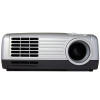
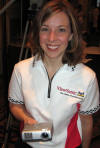
| As all the rich baby-boomers retire to their motor homes, they will want this satellite TV antenna. It uses a combination of motorized steering and phased-array technology to point to the satellite, even while moving. Phase-array technology comes from the military and is usually used for radars. Just $6995. | 

|

| Interesting twist on the USB drive - the Lexar Mercury uses "e-paper" display technology to indicate how full your memory is. The e-paper display means it displays the percent full even when unpowered and unplugged. Pricing has not been determined, but expect it to cost $5 to $10 over equivalent drives. | 
| Cute wireless internet radio/MP3 player from Torian Development. Uses hotspot WiFi and constantly updated database to pick up the internet radio station you want. Has 256 MB SD memory card, and 5 to 8 hour battery. Look for the Infustion in April for about $199 |
Takes the prize for most "exotic" product for the computer geek that owns everything else - the Nethrone from EMA Innovations. You recline and adjust the keyboard and monitor to taste. The seat even vibrates. Just $2495 | . 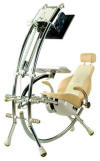

| Perhaps the coolest product shown this day - the SkyScout from Celestron. It has no magnification, but you look at any star, planet or constellation through the viewer and it tells you what it is. GPS, compass and tilt sensors figure out what you are pointing to. You can also ask it to help you find any night sky object. A red indicator dot tells you where to scan until you've found it. $399. | 

|
CES - Day 0 (January 4) |
| The day before CES officially starts is used by the big companies to announce their new products. |

| LG's PM70 4.3" widescreen portable media player, flanked by some smaller media players. | 
| LG's MIGO phone for young children. The child can only dial one of four preset numbers (e.g. phone home), and 911. |
| The battle for HDTV optical media heats up with Toshiba's announcement of a set of HD-DVD products. Two consumer players, HD-XA1 and HD-A1, priced at $799 and $499, respectively, and a Qosmio (strange name) laptop with HD-DVD R/W drive. More on Toshiba will follow later, particularly on their SED technology. | 
| Meantime, the Blu-ray companies trotted out several consumer players and PC R/W drives themselves. These companies were not as transparent about the expected pricing and delivery, saying the usual "when it comes out it will be priced competitively." Pioneer did mention their BDP-HD1, coming out in May at $1,800 - but quickly added this was not a consumer product. Panasonics unit is shown to the right. | 
|


| Speaking of Panasonic, they had to sit silently while Samsung and LG bragged about their huge Plasma TVs the last two years. Panasonic is actually a leader in Plasma sales and technology. Now they've shown their 103" plasma TV, beating last year's 102" TV from Samsung. No price/availability was given. | 
| Panasonic previously announced their OCAP television. This time they announced an agreement to work with Comcast on new OCAP applications. Panasonic is also giving Comcast their OCAP middleware so others can use it. Brian Roberts, CEO of Comcast is accepting Panasonic's first OCAP STB from Yoshi Yamada, CEA N.A. Panasonic. |
| Philips claims to be back on their feet in CE products in N.A. They like to position themselves as innovators. Most of their energy seems to have gone into making variations of Ambilight, now with 3 and 4-sided versions. They also announced a Blu-ray player and PC drive with no specifics. | 
| Thomson started the presentation by saying they are getting out of the CE device business. Instead, the RCA, GE and other brands are being used by partner companies. Having said that, they then went on to talk about all of "their" CE devices. Thomson is actually a force in production equipment, having bought companies like Grass Valley and Technicolor. | 
|

| Most of Pioneer's talk was about car navigation, which is finally starting to be a real market in the U.S. Shown left (being held in his right hand) is the Inno XM radio with 1 GB memory for recording and playback. Find it for $399 in March. | 
| Bill Gates is sitting in front of a three-panel display used to illustrate Microsoft's vision. There really wasn't much new that was announced. It was mostly demonstrations of Vista and a few programs like an MTV partnership in their URGE media subscription service. |
CES - Day 1 (January 5) |
| This is the first full day of CES. More of the big names hold their press conferences and the show floor is open. The show has grown again and needed to add the Sands Expo Center, making it even more difficult to see everything. |
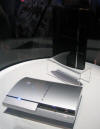
| Folks that saw the Sony Playstation 3 said it blew away the XBox 360 in graphics. Of course, there is still the quality of good game play, and if designers put all their energy into making the graphics look good, less time is sometimes
left for game play development. Nonetheless, the graphics were pretty impressive. | 
| Sony joins the many mfrs. that introduced enhanced phones that can handle multimedia. This W810i will be coming out within the next couple of months. Price is determined by the carrier, but it handles quad-band for the international set. |
| This is Sony's eReader (sorry for the glare). It uses one of the "e-paper" display technologies that provides fairly good contrast (no spec was given, but it looked like perhaps 25:1) black & white high resolution display. Uses Memory Stick or SD. The display draws no power, except to change the display, so battery life is "7,500 page turns". Handles Sony's "BBEB" format and PDF. Uses Marlin DRM. It sits in a cradle to download books and charge the battery. Q2, $300 to $400. | 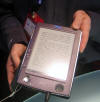
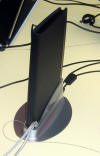
| Sony's 82" LCD is LED backlit, providing a wider color gamut - something that Sony likes to call xcYCC Color Space. This 1080p TV will eventually be sold under the Bravia line. Another prototype TV is the 55" SXRD model which is 30% thinner than the current 50" model. These WEGA models do not handle 1080p directly. Instead, they convert 1080p to 1080i, then display them in 1080p mode. Within a year this Band-Aid approach will be fixed. | 
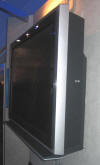
|

| People whine about the "HD-DVD & Blu-ray confusion". Well, even within a format there is room for confusion. Here are four different Blu-ray type media. But wait, in a few years you will start to hear about 4 and even 8 layer Blu-ray discs. Sony is getting "good signal to noise ratios" today, but 8 layers is still in the lab. | 
| XM radio popped up in more devices this year, and Samsung joined the crowd with a portable XM radio that will be released later this year. Like many of these type products this year. the Samsung model has built-in memory to record off the air so that you can listen to content later. |
| Portable video in all forms was a popular topic at this year's CES. Here is a Samsung phone that can receive video and be viewed on a display that twists for proper viewing orientation. | 
| Samsung also showed an 82" LCD TV (Sony gets their LCD panel from Samsung). | 
|

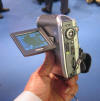
| Camcorders that use a HDD for storage media first came out a couple of years ago. With tiny disk drives improving in capacity and price (Toshiba's 0.85" drive is shown), the HDD Camcorder is getting more practical. Toshiba's GSC-R30 is one example. There will be a 30 GB and a 60 GB version, priced at $799 and $999, respectively. | 
| Sharp dropped plasma in favor of LCD and is now making sure their line handles 1080 x 1920 resolution for full HDTV. They used to have the largest LCD TV bragging rights, but didn't try to play that game this year. After all, how many people will really buy an 82" TV? |
| Toshiba and co-investor Canon both finally did a U.S. public showing of their SED display. They showed a prototype that was only 720p, but intend to go into production with 1080p. They played a demo video that highlighted image quality. Contrast ratio (probably not ANSI) is claimed to be 100,000:1 and switching time is 1 ms. It looked pretty good, but they were showing it in a completely dark room. | 

| As there was last year, there was a dedicated room for the LG-Philips LCD joint venture. Shown to the right is an LCD display using LED backlighting. The emphasis in this demonstration is the low power consumption (see watts meter lower right). Interestingly, they do not use Lumileds, even though Philips owns them. | 
|
CES - Day 2 (January 6) |
| Day 2 of CES might be described as the invasion of the outsiders. Both Yahoo and Google were keynote sessions, bringing in a new angle that is almost completely new, at least at the "keynote level" - services and content. Even though Microsoft and others have brought up these topics before, today's keynotes hit you over the head in a way that will change the direction of CES. |




| Yahoo started the day with their keynote address by Terry Semel, CEO of Yahoo. It is now expected that you will have a celebrity on stage, so Tom Cruise was brought in - mostly to promote his movie than Yahoo. Ellen DeGeneres was brought in to act as the typical frustrated consumer which Yahoo rescues with their new products. Yahoo talked about their Dashboard & Widgets, Go Mobile (location-based services through your mobile phone), and Go-TV (some of it working with TiVo. Yahoo's Go service is free and will be available via Cingular (you pay Cingular for data packet usage). It will work on the Nokia 6682. | 

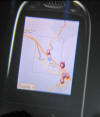
| Google's co-founder Larry Page gave his talk at the end of the day. He rode in on the automated car that won the recent DARPA contest. In sharp contrast to any keynote ever given at CES, Larry lectured the CE industry in a Mr. Roger's style on several issues the industry needed to address (e.g. standards). His celebrity was Robin Williams, which further added to the totally unscripted "this industry needs a kick in the pants" style of talk. Larry introduced Google's mobile services (ncluding maps on your phone), Google Pack software (pack.google.com) and Google Video Store (video.google.com check after Jan 15). The latter is particularly worth checking out. Content will include all NBA games and CBS's library. Individuals can publish and charge for video, too. |
| CEA's Gary Shapiro talks with the FCC's Kevin Martin. In contrast to Powell (former head of FCC), Kevin is more subdued - almost shy - when addressing the questions. Big on his agenda is preparing for the DTV switch and the spectrum auction that must take place in 2008. Controversial topics like decency, a la carte cable, and others were given generalized answers. | 
| Automotive electronics used to be about big speakers and fancy radios. This year saw several new products in video and navigation. To underline the video, here is photo of a van with video displays just about anywhere you can put them, including inside the rearview mirror. | 
|
CES - Day 3 (January 7) |

| The IOPS Z5 - probably the smallest MP3/MPEG4 video player you will ever find, unless you drop it behind the couch cushion. Up to 1GB memory. Runs 8 hrs of music or 3 hrs video on a charge. Not available in the U.S. yet, but several companies are looking at it. You can actually see useable video on this display. What would you pay for this? | 

| Yamaha introduced this YSP-1000 last month. It has several dozen tweeters and a pair of mid-range speakers in it. They phase adjust the signal to each speaker so that it simulates a surround sound arrangement. Rear sound is created by bouncing sound off of side walls. The speaker does not need to be in front of you to work. A microphone is used to calibrate the room once. Priced at $1500. A smaller version is $800. |
| There were several products based on MoCA at the show, including this Ethernet adapter from Panasonic. | 
| Interesting display by Pioneer showing the progression of image quality and power consumption of plasma TVs over the past few years. The differences were more obvious when viewed live. Pioneer calls their newest panel system PureVision. | 
|

| Nice photo of the relationship between a 7th generation LCD panel and a 40" television panel. Hard to appreciate the actual size of this glass until you have to look up to see the top edge. | 
| There were at least four demonstration or production LCD televisions using LEDs as a light source. There was at least one DLP television demonstrated with LEDs as a light source. The wider color gamut is easy to see in side-by-side comparisons. Difficult to appreciate from a photo, but this one shows Sanyo's demonstration. No one said they were using Lumileds, and no one wanted to say who they were using. |
| Well, it finally just about happened. This is pretty close to a true "photo-video" camera. It takes 28 minutes of 720 x 1280 30fps video onto a 2 GB SD card. It is the Sanyo Xacti-HD1. You can even take a photo while you are taking a video (some modes will cause a short glitch in the video when you do so). If you want to shoot in 16:9 you need to add a lens. This will be out in March for $799. | 
| Sanyo also introduced the world's first 2K LCD digital cinema projector. This looks like it is for smaller venues, much like the Sony 4K projector. Existing digital cinema projectors use DLP or LCOS. The LCD engine is claimed to be lower cost, according to Sanyo. Expected price is around $75K, which is below other projectors. | 
|

| Last year Dell showed off their television products much more than they did this year. This time most of the focus was on their PC products. In contrast, HP gave their televisions about equal billing to their photo printers and cameras. | 
| Cisco bought Linksys, and Linksys bought Kiss Technologies - a European company. This is a product that used cabled or 802.11b/g to send HD video from one room to the next. It can also grab content from the Internet. One version has build-in storage. The version without storage will be priced at about $600 when it comes out in a couple of months. It will be branded Linksys, though the same product keeps the Kiss brand in Europe |
| This got attention from women buyers. Press a button the plasma TV disappears behind a painting. | 
| While this demo was used to impress you with their "single scan" plasma technology, it was equally interesting just to see the guts of the television. | 
|
CES - Day 4 (January 8) |

| This LG "wall projector" is currently selling in Europe for about $3K Euros. It weighs about 8.5 kg, uses a 200W lamp, and accepts HDMI. It comes in black and white. LG is evaluating the U.S. market and does not have a firm intro date or price. This product seemed to be getting lots of attention. | 
| This is a screenshot of the Mediabolic UI for DLNA. We did a simple test to see what happened when a device on the network was unplugged and then plugged in again. After some delay the system correctly recognized it. DLNA recently approved the use of DTC:/IP, so we will be seeing more of this, particularly as Intel spends some of their Viiv ad money on their next release. |
| LG is working with Comcast as OCAP begins to unfold. Since Korea already picked OCAP, LG and Samsung have a leg up. The screenshot if from a Comcast OCAP application, running two-way services. | 
| LG is also working with Comcast on a downloadable conditional access system. Interestingly, Comcast choose a USB dongle for the second line of defense for renewability. Not sure what the final spec will be. | 
|

| HD-FVD is a HDTV format created in Taiwan. They hope to convince China to adopt it, though China is working on their own stuff. HD-FVD uses a red laser, not blue. WM9 compression affords reasonable storage of movie length content. Tthe HD-FVD disk has slightly more capacity than a standard DVD; but, the system can use HD-FVD files from a standard DVD disk that you burned on you PC, too. The big advantage is low cost. | 

| This is the Slimouse. You can only buy it online, but they are looking for a U.S. distributor. It currently sells in Japan. The expected U.S. price is about $25. It took a little time to get used to, but they claim it will be easier on the user than traditional travel mouses. |
| Hongli Opto-Electronics sells these LED strips by the meter. A 5 meter string, with sticky tape backing is about $125. Water proof versions also exist. It runs on 12 volts, so expect to see this show up in cars with loud stereos. Also look for this in fancy home theaters. | 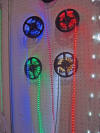
| A-Data's FPI Fingerprint-secured USB drive. You can't access the contents unless your fingerprint matches. Good for paranoid people that have a tendency to forget where they left their car keys. | 
|
ICCE (January 9 - 11) |
| The International Conference on Consumer Electronics is an IEEE run and CEA sponsored event aimed at the technology used in the industry. It consists of hundreds of deeply technical papers presented by the leading worldwide CE companies and universities. Most papers come from Japan, Korea, Taiwan, Netherlands and some from the U.S. It is obviously difficult to cover technical topics in this format, but nonetheless, you might get a sense for what the engineers have in store for the future by looking at some of the following photos and comments. |

| The IEEE awards a Sony sponsored Ibuka (a founder of Sony) Award each year at ICCE. Wayne Bretl, Richard Citta & Wayne Luplow were part of the team that created the VSB transimission system now used for ATSC DTV in the U.S. They are shown here accepting their Ibuka Award. | 

| Flat panel televisions squeeze the size of the speakers. Panasonic created a new elongated magnetic drive mechanism resulting in some very skinny speakers. They actually sounded very good, particularly considering they were demonstrated in the open, as seen in the photo. |
| Korea has a strong research culture in universities and institutions (e.g. ETRI). Here is one university paper on a content protection scheme for MPEG4-based IPTV. | 
| With many companies pinning their hopes on mobile phone video, there is lots of attention on the video quality one gets. Wireless has high bit error rates and one bad frame can mess up the image for seconds. This paper used temporal interpolation to minimize the problem. The photo is from "Foreman", one of the standard test videos used to test & compare technologies. |  |



| With blue laser DVD about to show up in real products (whether HD-DVD or Blu-ray), the issue of backwards compatibility comes up. Toshiba showed their method for a player optical pickup unit that works for CDs, DVDs and HD-DVD. It uses a diffraction grating to bend the red beam used for CDs to better position the optics so that one OPU does it all. | 
| The new DVD formats have fancier menus. This photo shows how the video can be playing in the background while image-based menus are shown in the foreground. Also, you can have director's comments and video shown in a picture-in-picture box. |
| One of the functions of CEA is standards creation. An example is Active Format Description (AFD). AFD is a 4 bit code that describes what part of the image is important for display. AFD can help prevent the wrong aspect ratio from being used, or to optimize the viewed image when the image does not match the display. It will be a few years before consumers see this. | 


| Sony, IBM and Toshiba have been promoting their Cell processor for CE applications. Toshiba is using it in future digital television sets. This gives a peek at how they use Cell's parallel processing to split up the video and audio processing. Each processing cell is assigned a function and runs code that is resident in that cell. Data is passed through the system via a DMA bus. | 


|

| While done as via simulation, this paper shows the challenge system designers have as processor clock frequencies increase, and one of the reasons parallel processing is winning over clock speed these days. You no longer have clean "1" and "0" signals on the bus, and must employ sophisticated RF transmission techniques that used to be used by the military for microwave signals. | 
| With an increasing amount of video content collecting on people's systems, the issue of quickly finding the video you want increases in importance. There were several papers on this subject, including this one that showed a novel graphic approach to searching through a video program. |
See photos and comments from the 2005 CES & ICCE |